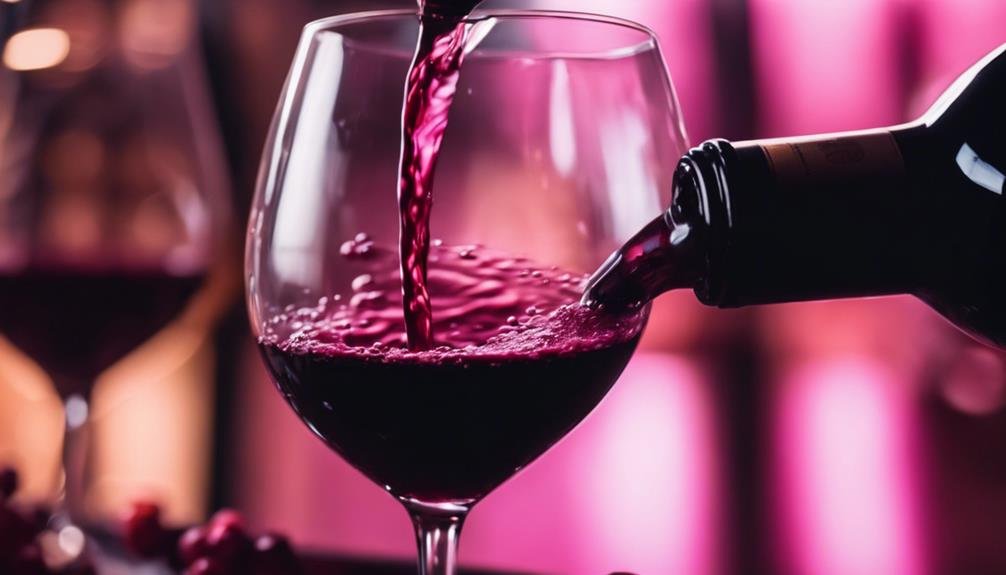In the world of rosé wine, discover a range of colors from pale pink to vibrant salmon and flavors like red fruits, flowers, citrus, and melon. Production methods like maceration and saignée play a role in creating these diverse taste profiles, with influences from grape varieties and terroir. Serve chilled at 45-55°F to enjoy with grilled seafood, salads, or light pasta dishes. Rosé's allure lies in its delicate hues, unique flavors, and complex production methods that promise a truly diverse tasting adventure. Additional discoveries await those seeking a deeper understanding of this enchanting wine.
Rosé Wine Characteristics
Rosé wine, nestled elegantly between red and white varieties, boasts a delicate hue crafted by winemakers who expertly control the color through the removal of red grape skins during production. This elegant wine comes in various color variations, ranging from pale pink to vibrant salmon.
Rosé wine offers a wide array of flavor pairings, including red fruit, flowers, citrus, and melon. The finish can sometimes present a crunchy green flavor reminiscent of celery or rhubarb. Depending on the grape used, the flavor profiles of rosé wine can vary greatly.
For example, Aglianico rosé may offer cherry and orange zest notes, while Grenache rosé from Provence might have hints of honeydew melon, lemon, and celery. The versatility of rosé wine makes it a delightful choice for a range of dishes and occasions.
Tasting Notes and Profiles
When exploring the tasting notes and profiles of rosé wine, one encounters a diverse array of flavors and aromas that reflect the grape varietals and production methods employed.
- Rosé wines often exhibit flavors of red fruit, flowers, citrus, and melon.
- Different grape varietals result in varying flavor profiles, such as cherry and orange zest in Aglianico rosé or honeydew melon, lemon, and celery in Grenache rosé from Provence.
The finish of rosé wine can offer an invigorating and diverse flavor profile, sometimes with a crunchy green note like celery or rhubarb.
To enhance the tasting experience, consider pairing rosé with foods like grilled seafood, salads, or light pasta dishes. Serve rosé wine chilled at temperatures between 45-55°F to fully appreciate its flavors and aromas.
Production Methods Overview

Exploring the intricacies of wine production methods provides valuable insight into the craftsmanship and techniques employed to create the diverse array of rosé wines available in the market.
Color control is an essential aspect of rosé wine production, where winemakers carefully manage the grape skins' contact time to achieve the desired pink hue. This control allows for a spectrum of colors, from pale salmon to deep ruby, influencing the wine's visual appeal.
Flavor variations in rosé wines are vast, influenced by factors such as grape variety, terroir, and production methods. From fruity and floral notes to citrus and melon undertones, the flavor profile of rosé wines can vary significantly, offering a broad range of taste experiences for wine enthusiasts.
Maceration Method Details
The maceration method in rosé wine production involves allowing red wine grapes to soak in juice, resulting in a darker-colored wine with a richer flavor profile. This method is widely used in regions like Provence and Languedoc-Roussillon, France.
Key aspects of the maceration method include:
- Skin Contact: Red grape skins are in contact with the juice for around 2-20 hours.
- Flavor Extraction: This process allows for the extraction of flavors and color compounds from the grape skins.
- Richer Flavor Profile: The extended contact between the skins and juice enhances the flavor complexity of the resulting rosé wine.
- Commonly Used: Maceration is a prevalent method for producing rosé wines known for their vibrant hues and robust flavors.
Saignée or Bled Method Insights

Moving from the maceration method to the Saignée or Bled method in rosé wine production reveals a contrasting approach to creating this delightful wine variety. The Saignée method involves bleeding off juice from red wine production to create rosé wine, concentrating the intensity of the red wine. This winemaking technique results in rosé wines with a bolder flavor profile compared to those made using the maceration method. Saignée wines are less common and usually represent a small portion of a winery's production. The process of bleeding off juice during red wine production to make rosé enhances the flavor concentration, offering a unique tasting experience for wine enthusiasts.
| Saignée Method Insights | |
|---|---|
| Flavor Concentration | Intense |
| Winemaking Technique | Concentration |
Frequently Asked Questions
What Makes Rosé Wine a Versatile Option for Food Pairing?
Rosé wine's versatile food pairing capabilities stem from its diverse flavor profiles and balanced acidity. With notes of red fruit, citrus, and melon, it complements a wide range of dishes from seafood to salads, making it a culinary chameleon.
Can the Color of Rosé Wine Indicate Its Age or Quality?
The color of rosé wine does not necessarily indicate its age or quality. While darker hues may suggest longer skin contact during production, quality markers in rosé wine are primarily determined by grape variety, winemaking techniques, and overall flavor profile.
Are There Specific Regions Known for Producing Exceptional Rosé Wines?
Some regions excel in producing exceptional rosé wines. Provence vineyards are renowned for their delicate and aromatic rosés, while Spanish rosés offer robust flavors with a touch of Mediterranean warmth. These regions showcase the diverse spectrum of rosé production.
How Does the Alcohol Content in Rosé Compare to Red and White Wines?
The alcohol content in rosé wine typically falls between that of red and white wines. This versatile pink wine is known for its invigorating flavor profiles and can range from dry to sweet depending on production methods and fermentation techniques.
What Are Some Popular Trends or Innovations in Rosé Wine Production?
Popular trends in rosé wine production involve sustainability practices such as organic farming. Winemakers are focusing on indigenous grape varieties and implementing modern techniques to enhance quality and uniqueness. These trends reflect a growing consumer interest in eco-friendly and distinctive wines.
Conclusion
To sum up, Rosé wine offers a spectrum of flavors and characteristics that make it a unique and versatile choice for wine enthusiasts.
From its delicate pink hue to its invigorating taste profile, Rosé wine continues to captivate drinkers worldwide.
Have you ever wondered how the subtle nuances of Rosé wine can transport you to a sun-soaked vineyard with just one sip?